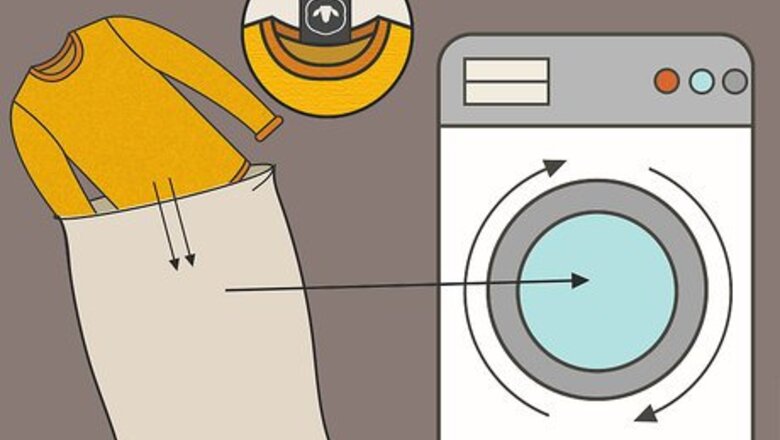
views
- Wool can shrink dramatically with very little effort; if you’re going to try and shrink a wool item on purpose, recognize that it’s very easy to overdo it and you may end up ruining the item.
- Washing a wool item in a washing machine with hot water will shrink it dramatically; this is generally not recommended unless you’re trying to go from a XXL to a medium or something like that.
- If you want a more controlled shrinking, spray the wool with a little water and throw it in the dryer on medium heat; check the wool item every 2-5 minutes to see if you’re happy with the new size.
Using a Washing Machine for Extensive Shrinkage
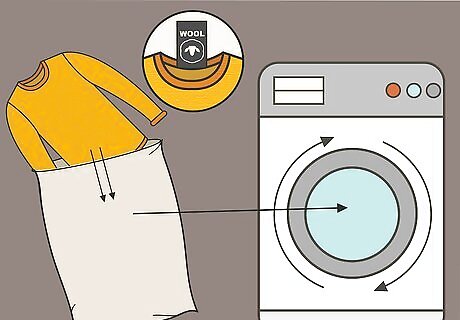
Place your garment in a pillowcase before washing. Wool is a very delicate material. Agitation will cause it to shrink, but if it gets roughly twisted while in the washing machine, it could be permanently damaged. Place your wool garment in a pillowcase or mesh bag and knot the top before putting it in the machine in order to protect it while it’s being washed.

Wash using high heat and a short, gentle cycle. Wool fibers have microscopic scales that “lock” on to one another when vigorously handled or exposed to high temperatures.This “locking” is what causes woolen fabrics to shrink under while swirling around in a warm washing machine. Using a short, gentle cycle will prevent excessive shrinkage or damage. Use a small amount of gentle, bleach-free detergent. Check on your garment every few minutes by stopping the cycle and pulling it out – it may shrink more quickly than you expected. If so, you’ll want to pull it out before the cycle is over.
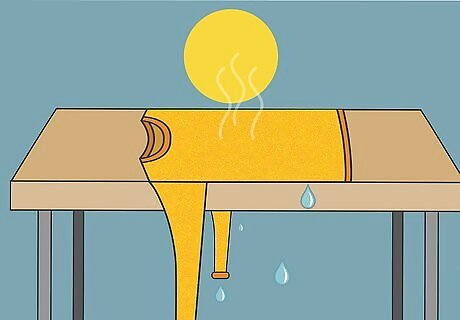
Lay the garment on a flat surface to dry. If your garment has shrunk to the correct size, carefully lay it on a flat surface, smoothing out any wrinkles or folds. The wool fibers can still be altered while wet, so don’t wring or hang your garment – you could risk stretching it out or damaging it.
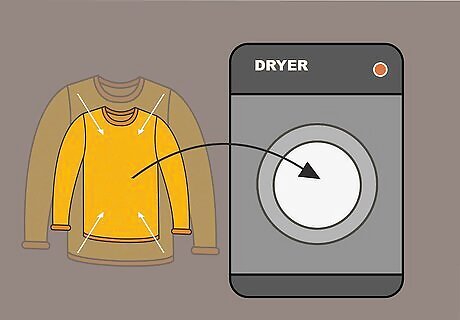
Put your garment in the dryer if you’d like it to shrink more. If your garment isn’t quite the size you had hoped it would be after washing it, place it in your dryer. Use a short cycle and low heat, and continue to pause the cycle and check on the garment periodically to make sure it doesn’t shrink too much. Clara Parkes Clara Parkes, Wool Historian and Textile Expert Wool's complex fiber structure enables controlled shrinking through the process known as felting. This process tightens fibers together using water, heat, and agitation to achieve the desired texture and fit. However, too much heat or agitation causes irreversible changes. Successful wool shrinking requires controlling these elements to enhance its natural beauty and functionality.
Using a Dryer for Minor Shrinkage
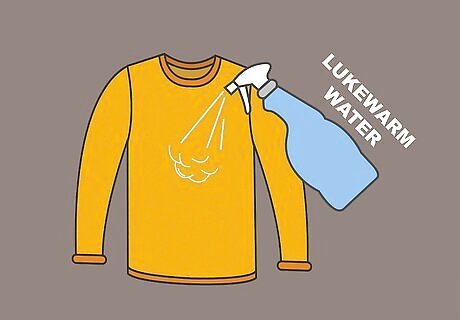
Spritz your wool with a light mist of water. If you want to shrink your garment only a slight amount, use a spray bottle filled with water to dampen the fabric (but not soak it) before putting it in the dryer. Make sure the water is lukewarm. Spraying your garment with water that’s too hot could cause it to shrink to a smaller size than you intended.
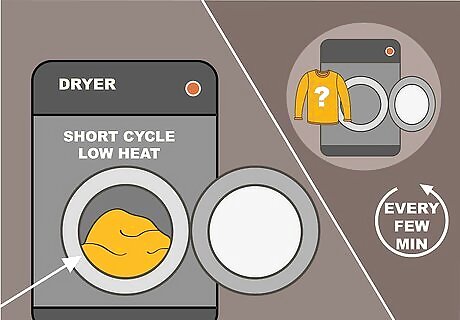
Put your dampened wool garment in the dryer. Use a short cycle and low heat, because intense agitation and high temperatures can cause wool to shrink quickly. Drying the wool for a short period of time at a lower temperature will prevent it from shrinking too much. Once again, check on it every few minutes – you can pull it out if it’s shrinking too quickly.
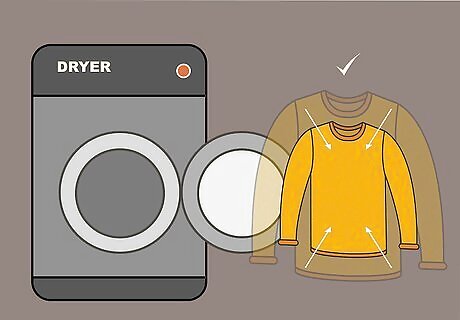
Remove your garment from the dryer once it has shrunk to the desired size. Try it on to ensure that it fits. If it does, great! It’s ready to wear. If not, spritz it with water again and put it in the dryer for another short, gentle cycle, continuing to check on it every few minutes.
Shrinking Wool by Hand
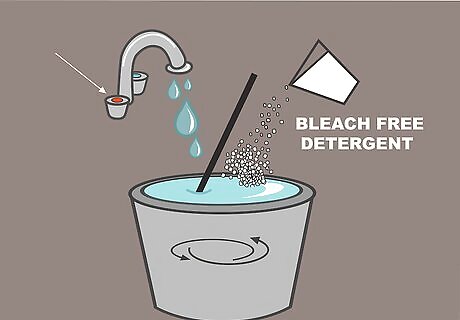
Mix a warm, gentle cleaning solution. Fill a sink or a tub with warm water, add a small amount of bleach-free detergent, and mix gently using your hands.
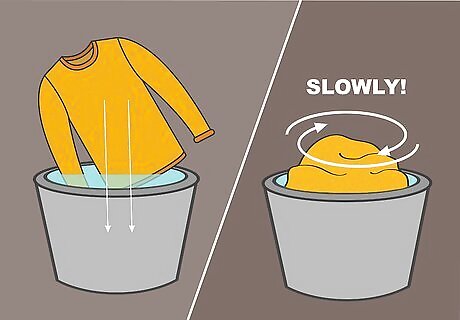
Submerge and gently swirl the garment in the water. After you place your garment in the warm water mixture, swirl it slowly and carefully beneath the surface of the water, once every 2-3 minutes. This gentle motion will encourage the fibers to shrink. Avoid twisting or bunching the fabric while swirling - it could lead to permanent damage.

Monitor the garment’s shrinking progress. Each time you swirl the garment in the water, pull it out briefly evaluate how much it has shrunk. This is important to ensure that it ends up shrinking to the desired size – wool can often shrink faster than you expect it to. When you feel it has shrunk enough, it will be time to remove it from the water. Your garment should be submerged for between 5 and 10 minutes overall.

Remove and dry the garment. When you pull the soaked garment out of the water, lay it flat and blot it with an absorbent towel. Alternatively, you can press the flattened garment against a nearby wall to squeeze the water out. Again, be sure not to twist or bunch the garment while you’re drying it. This could damage it or reshape differently than you had originally intended.
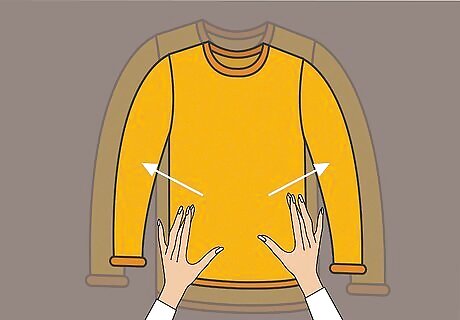
Reshape the garment. Push the wool fibers together by pressing your fingers inward and toward each other. This will tighten the fabric and make sure any shrinkage that occurred while it was soaking in water becomes permanent. If there is a specific part of the garment you want to shrink, push the fabric inward in that area only. If you want to shrink the entire sweater, repeat this action across its entire surface area.
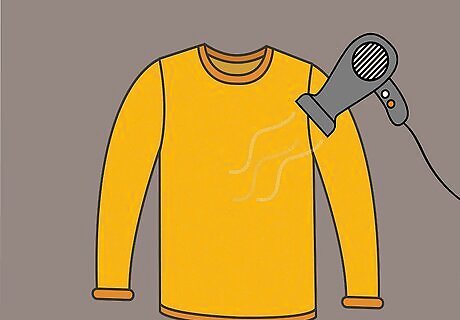
Target specific areas of the garment using a hair dryer, if desired. Using a hair dryer can speed and intensify shrinkage in specific areas. If you’re attempting to shrink a certain part of the garment – such as stretched-out sweater cuffs – reshape them by pressing your fingers inward to reduce them to the desired size. Then, turn on high heat and volume, and blow-dry the spot you wish to shrink until it is barely damp.

Lay the garment flat to allow it to dry. Once you’re done reshaping the garment, lay it flat on a clean, dry surface, arranging it in its desired shape. Make sure the surface is out of the way of pets and children, and don’t hang your garment up – you could risk stretching it out again.


















Comments
0 comment